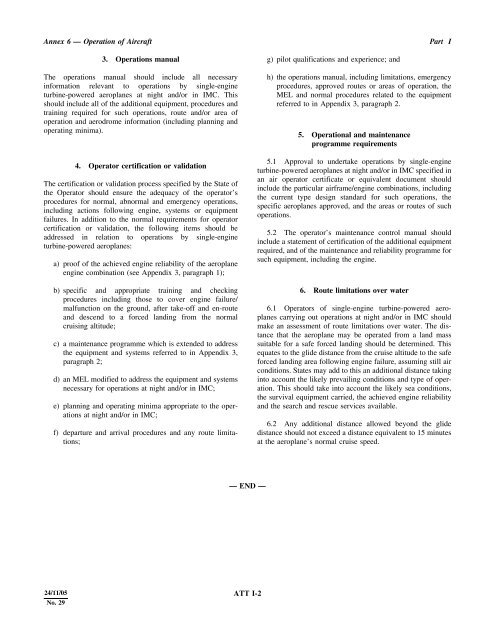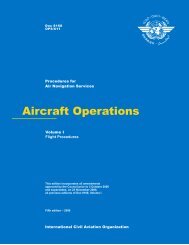Operation of Aircraft
Annex 6, Part I
Annex 6, Part I
- No tags were found...
You also want an ePaper? Increase the reach of your titles
YUMPU automatically turns print PDFs into web optimized ePapers that Google loves.
Annex 6 — <strong>Operation</strong> <strong>of</strong> <strong>Aircraft</strong><br />
Part I<br />
3. <strong>Operation</strong>s manual<br />
The operations manual should include all necessary<br />
information relevant to operations by single-engine<br />
turbine-powered aeroplanes at night and/or in IMC. This<br />
should include all <strong>of</strong> the additional equipment, procedures and<br />
training required for such operations, route and/or area <strong>of</strong><br />
operation and aerodrome information (including planning and<br />
operating minima).<br />
4. Operator certification or validation<br />
The certification or validation process specified by the State <strong>of</strong><br />
the Operator should ensure the adequacy <strong>of</strong> the operator’s<br />
procedures for normal, abnormal and emergency operations,<br />
including actions following engine, systems or equipment<br />
failures. In addition to the normal requirements for operator<br />
certification or validation, the following items should be<br />
addressed in relation to operations by single-engine<br />
turbine-powered aeroplanes:<br />
a) pro<strong>of</strong> <strong>of</strong> the achieved engine reliability <strong>of</strong> the aeroplane<br />
engine combination (see Appendix 3, paragraph 1);<br />
b) specific and appropriate training and checking<br />
procedures including those to cover engine failure/<br />
malfunction on the ground, after take-<strong>of</strong>f and en-route<br />
and descend to a forced landing from the normal<br />
cruising altitude;<br />
c) a maintenance programme which is extended to address<br />
the equipment and systems referred to in Appendix 3,<br />
paragraph 2;<br />
d) an MEL modified to address the equipment and systems<br />
necessary for operations at night and/or in IMC;<br />
e) planning and operating minima appropriate to the operations<br />
at night and/or in IMC;<br />
f) departure and arrival procedures and any route limitations;<br />
g) pilot qualifications and experience; and<br />
h) the operations manual, including limitations, emergency<br />
procedures, approved routes or areas <strong>of</strong> operation, the<br />
MEL and normal procedures related to the equipment<br />
referred to in Appendix 3, paragraph 2.<br />
5. <strong>Operation</strong>al and maintenance<br />
programme requirements<br />
5.1 Approval to undertake operations by single-engine<br />
turbine-powered aeroplanes at night and/or in IMC specified in<br />
an air operator certificate or equivalent document should<br />
include the particular airframe/engine combinations, including<br />
the current type design standard for such operations, the<br />
specific aeroplanes approved, and the areas or routes <strong>of</strong> such<br />
operations.<br />
5.2 The operator’s maintenance control manual should<br />
include a statement <strong>of</strong> certification <strong>of</strong> the additional equipment<br />
required, and <strong>of</strong> the maintenance and reliability programme for<br />
such equipment, including the engine.<br />
6. Route limitations over water<br />
6.1 Operators <strong>of</strong> single-engine turbine-powered aeroplanes<br />
carrying out operations at night and/or in IMC should<br />
make an assessment <strong>of</strong> route limitations over water. The distance<br />
that the aeroplane may be operated from a land mass<br />
suitable for a safe forced landing should be determined. This<br />
equates to the glide distance from the cruise altitude to the safe<br />
forced landing area following engine failure, assuming still air<br />
conditions. States may add to this an additional distance taking<br />
into account the likely prevailing conditions and type <strong>of</strong> operation.<br />
This should take into account the likely sea conditions,<br />
the survival equipment carried, the achieved engine reliability<br />
and the search and rescue services available.<br />
6.2 Any additional distance allowed beyond the glide<br />
distance should not exceed a distance equivalent to 15 minutes<br />
at the aeroplane’s normal cruise speed.<br />
— END —<br />
1/11/01 24/11/05<br />
ATT I-2<br />
No. 29












